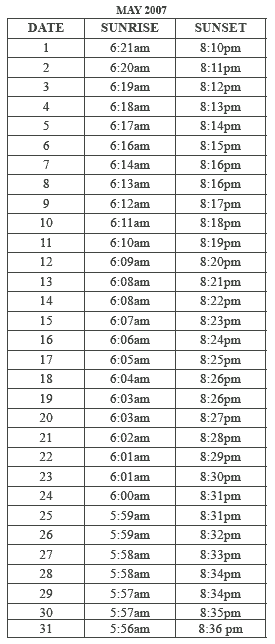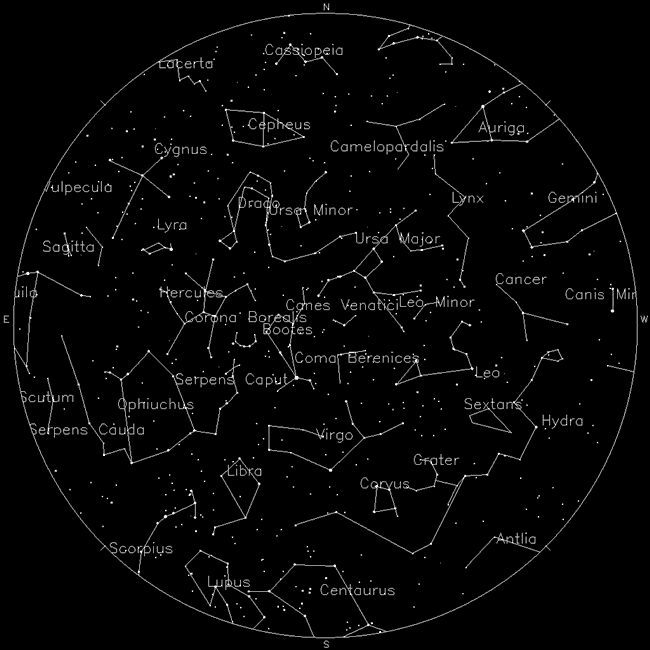Meteor Showers
A weak display at best, The Eta Aquarids Meteor Shower is
compromised this year by the waning full moon of May 2.
The meteors radiate from the constellation Aquarius which
rises in the northeastern sky, to the south of Cassiopeia,
after midnight. Peak viewing time is May 6-12.
Blue Moon
Blue moons are rare no matter how you define them. The phrase
has been used for hundred of years to refer to rare, absurd,
or unlikely occurrences. It is true that the moon can look
blue, if the sky is fulled with volcanic dust or smoke particles
from huge forest fires. As you may have guessed, it does
not happen often. The Maine Farmers Almanac laid the groundwork
for the current definition of blue moon back in the 1930’s
and 1940’s. A typical year has 12 full moons, three
full moons for each of the four seasons. Occasionally, there
would be 13 full moons in a year because the moon’s
orbit of 29-1/2 days is shorter than most calendar months
(February excepted). Each month’s full moon had a name
and was sometimes used to determine religious observances.
The Almanac cast the fourth full moon of that particular
season as the oddball, and one of its astronomers called
it the Blue Moon. That left the moon name nearest the solstice
or equinox intact. The formula for calculating these Blue
Moons was later discovered but misinterepreted by a reporter
for Sky and Telescope Magazine and then later picked up by
the radio program Star Date. As a result, we now consider
a blue moon to be the second full moon within a calendar
month. By either definition, a blue moon is rare. They usually
occur every two to three years, although some years have
had two blue moons by the current definition. Blue Moons
can occur in both January and March of the same year, leaving
February without a full moon of its own.
MOON HAPPENINGS
A full moon rises on Wednesday, May 2, at 8:57 pm and again
on Thursday, May 31, at 8:53 pm. In Canyon Country these
times may be delayed by one-half hour or more, depending
upon your viewing site. The moon sets about one hour later
each night during the first week of May. By then it is
rising after midnight and setting before sunset until May
16. the new moon occurs on May 16, after which it reappears
in the western sky at sunset. On May 17 look toward the
western horizon for the elusive planet Mercury near a slender
crescent moon soon after sunset. On May 19 the planet Venus
will be close to the waxing crescent. The waxing moon appears
higher in the sky each night. By the second full moon on
May 31, it will rise about 20 minutes after sunset.
VISIBLE PLANETS
Jupiter - rises before midnight at the
beginning of the month and around 9:00 pm by the end
of the month
Mars - rises in the early
morning hours and sets well before sunset
Mercury -
visible during the last half of May soon after twilight
in the western sky; on May 17 look for it near the crescent
moon;
Saturn - high in the western sky each evening,
just west of the mane of Leo the Lion
Venus - rises higher in the western sky
each evening, moving towards Gemini; on May 19 it passes
very near the crescent moon.
|

Sunrise is calculated as though the horizon is at the
same elevation as Moab. Dawn, or twilight, occurs
in three stages. Civil twilight occurs approximately
one-half hour before official sunrise; you can easily
function without artificial light. Nautical twilight,
about one hour before sunrise, may require artificial
light to assist your movements. Astronomical twilight
occurs about one and one-half hours before sunrise.
A faint glow will appear above the horizon. The same
progression applies to dusk. The surrounding cliffs
can prolongtwilight by up to one-half hour or more. |
Major
Constellations of April |
Northward
Ursa Major
Cassiopeia
Cepheus
Draco
Ursa Minor |
Eastward
Cygnus (Northern Cross)
Lyra
Ophiuchus
Aquila |
Southward
Hercules
Corona Borealis
Bootes
Libra
Virgo
Scorpius |
Westward
Leo
Corvus
Gemini |
|
|
By
the end of May, Vesta, one of only two asteriods visible
with the unaided eye, will appear as a bright star just south
of the constellation Ophiuchus. It will be as bright as the
star Antares just below Ophiuchus in the constellation Scorpius.
Hold the star chart high above your head and
match the compass directions to the
direction you are facing.

As the night and the
month progress, the
constellations will shift toward
the west. Gemini will move beyond
the western horizon by the end of the month.
|

